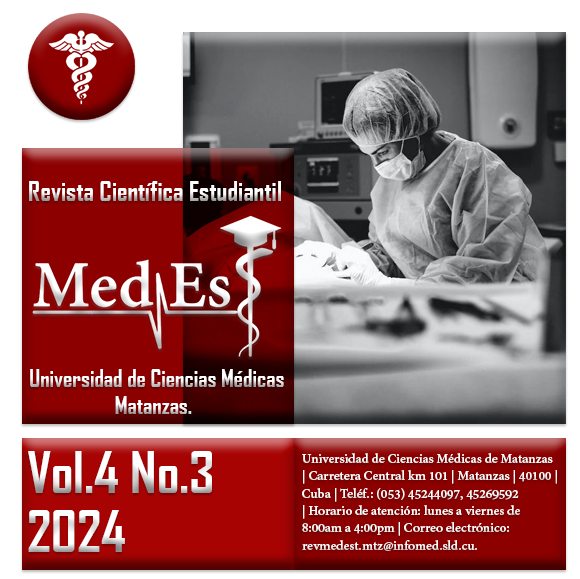Effectiveness of physiotherapy in the rehabilitation of burn injuries: presentation of a clinical case
Keywords:
Physiotherapy, Burns, Hypertrophic Scars, Rehabilitation, Therapeutic LaserAbstract
Introduction: Burns represent one of the most severe forms of physical trauma, with consequences that affect both functionality and the quality of life of patients. Despite the decrease in mortality, sequelae such as hypertrophic scars and joint limitations persist, requiring multidisciplinary approaches for rehabilitation. Physical therapy emerges as an essential component in this process, although its application must be adapted to the individual needs of each patient.
Objective: To evaluate the effectiveness of a comprehensive physical therapy protocol in the rehabilitation of a patient with severe burn sequelae, focusing on functional and aesthetic recovery.
Case presentation: This report describes the case of a 37-year-old man with severe burns to the head and upper limbs, who presented with joint limitations and hypertrophic scars. Treatment included therapeutic laser, physical therapy, pressure therapy, and occupational therapy for four months. The results showed significant improvement in joint arches, upper limb functionality, and the aesthetic appearance of the scars, allowing the patient to return to work.
Conclusions: The physiotherapy protocol applied proved effective in the rehabilitation of burn injuries, improving motor function, scar aesthetics, and patient quality of life. This case underscores the importance of a multidisciplinary and personalized approach to burn treatment, as well as the need to continue researching safe and effective therapeutic alternatives.
Downloads
References
1- Wiechman SA, Patterson DR. ABC of burns: Psychosocial aspects of
burn injuries. BMJ: British Medical Journal [Internet] 2020 [citado 01/01/2024]; 329(7462):391. Disponible en: https://pubmed.ncbi.nlm.nih.gov/15310609/
2- James SL, Lucchesi LR, Bisignano C, Castle CD, Dingels ZV, Fox JT, et al. Epidemiology of injuries from fire, heat and hot substances: global, regional and national morbidity and mortality estimates from the Global Burden of Disease 2019 study. Inj Prev. [Internet] 2020 [citado 01/01/2024]; 26(Supp 1):i36- i45. Disponible en: https://pubmed.ncbi.nlm.nih.gov/31857422/
3- Buhalog B, Moustafa F, Arkin L, Lee K, Siwy K, Donelan M, et al.b Ablative fractional laser treatment of hypertrophic burn and traumatic scars: a systematic review of the literature. Arch Dermatol Res. [Internet] 2021 [citado 01/01/2024]; 313(5):301-317. Disponible en: https://pubmed.ncbi.nlm.nih.gov/32926192/
4- Issler-Fisher AC, Waibel JS, Donelan MB. Laser Modulation ofHypertrophic Scars: Technique and Practice. Clin Plast Surg. [Internet] 2017 [citado 01/01/2024]; 44(4):757-766. Disponible en: 10.1016/j.cps.2017.05.007. https://pubmed.ncbi.nlm.nih.gov/28888301/
5- Soboleva AG, Sobolev VV, Karapetyan MM, et al. Laser Therapy Changes the Expression of Matrix Metalloproteinases in Bleomycin-Induced Skin Fibrosis. Life (Basel). [Internet] 2023 [citado 01/01/2024]; 13(3):810. Disponible en: https://pubmed.ncbi.nlm.nih.gov/36983965/
6- Schneider JC, Mathews K, Ryan CM. Burn rehabilitation outcomes: lessons learned from the uniform data system for medical rehabilitation. J Burn Care Res. [Internet] 2020 [citado 01/01/2024]; 35(3):212-3. Disponible en: https://pubmed.ncbi.nlm.nih.gov/23799485/
7- Van Baar ME, Essink-Bot ML, Oen IM, Dokter J, Boxma H, van Beeck EF. Functional outcome after burns: a review. Burns. [Internet] 2019 [citado 01/01/2024]; 32(1):1-9. Disponible en: https://pubmed.ncbi.nlm.nih.gov/16376020/
8- Richard R, Baryza MJ, Carr JA, Dewey WS, Dougherty ME, Forbes-Duchart L, et al. Burn rehabilitation and research: proceedings of a consensus summit. J Burn Care Res. [Internet] 2019 [citado 01/01/2024]; 30(4):543-73. Disponible en: https://pubmed.ncbi.nlm.nih.gov/19506486/
9- Procter F. Rehabilitation of the burn patient. Indian J Plast Surg. [Internet] 2019 [citado 01/01/2024]; 43(Suppl):S101-13. Disponible en: https://pubmed.ncbi.nlm.nih.gov/21321643/
10- Hege AR, Choubisa CA, Kasatwar P. Physiotherapeutic Rehabilitation of a Patient Following an Electrical Burn: A Case Report. Cureus. [Internet] 2022 [citado 01/01/2024]; 14(9):e29702. Disponible en: https://pubmed.ncbi.nlm.nih.gov/36320961/
11- Okhovatian F, Zoubine N. A comparison between two burn rehabilitation protocols. Burns. [Internet] 2020 [citado 01/01/2024]; 33(4):429-34. Disponible en: https://pubmed.ncbi.nlm.nih.gov/17466461/
12- Raipure A, Patil S, Pathan H. Effectiveness of Early Physiotherapy Rehabilitation Approach for Split Skin Grafting Post-burn in a Pediatric Patient. Cureus. [Internet] 2023 [citado 01/01/2024]; 15(8):e44083. Disponible en: https://pubmed.ncbi.nlm.nih.gov/37750141/
13- Choi KJ, Williams EA, Pham CH, Collier ZJ, Dang J, Yenikomshian HA, et al. Fractional CO2 laser treatment for burn scar improvement: A systematic review and meta-analysis. Burns. [Internet] 2021 [citado 01/01/2024]; 47(2):259-269. Disponible en: https://pubmed.ncbi.nlm.nih.gov/33288326/
14- Khatri KA, Mahoney DL, McCartney MJ. Laser scar revision: A review. J CosmetLaserTher. [Internet] 2022 [citado 01/01/2024]; 13(2):54-62. Disponible en: https://pubmed.ncbi.nlm.nih.gov/21401378/
Downloads
Published
How to Cite
Issue
Section
License
Copyright (c) 2025 Javier González-Tarifa , Ariel Luis Oviedo-Bravo , Marilia Ríos-García , Yaily Naranjo-Pérez

This work is licensed under a Creative Commons Attribution-NonCommercial 4.0 International License.
Those authors who have publications with this journal accept the following terms: The authors will retain their copyright and guarantee the journal the right of first publication of their work, which will be simultaneously subject to the Recognition License. Creative Commons that allows third parties to share the work as long as its author and its first publication in this magazine are indicated. Authors may adopt other non-exclusive license agreements for the distribution of the published version of the work (e.g.: deposit it in an institutional telematic archive or publish it in a monographic volume) as long as the initial publication in this journal is indicated. Authors are allowed and recommended to disseminate their work through the Internet (e.g.: in institutional telematic archives or on your website) before and during the submission process, which can produce interesting exchanges and increase citations of the published work.





